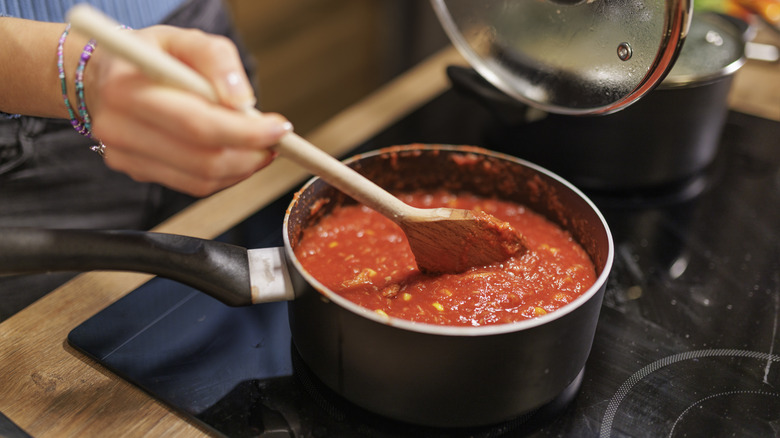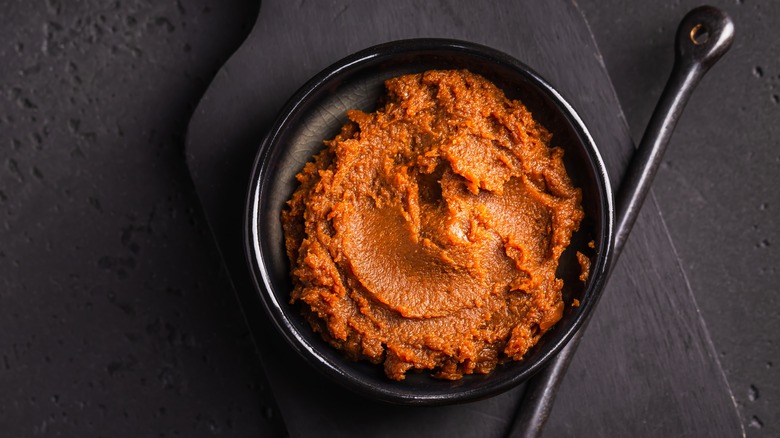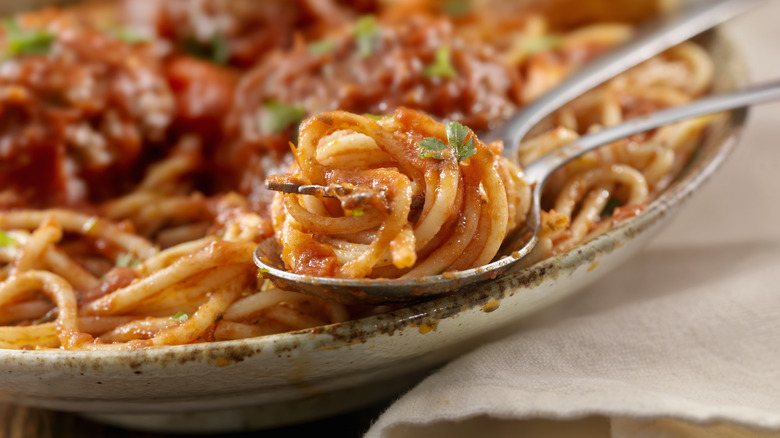The Secret Umami Ingredient That Adds A Punch To Spaghetti Sauce
One particular culinary secret weapon can elevate an ordinary dish into something extraordinary: miso. It can be added to numerous foods — but the traditional Japanese fermented soybean paste in classic spaghetti sauce is simply brilliant. It doesn't just amplify the iconic, tomato-based pasta sauce's flavor profile; it enhances the overall dining experience by imparting a rich depth, which complements the familiar Italian staple with its distinct charm. This unassuming paste can make a simple marinara play a symphony of flavors.
Miso introduces a robust, elegant, umami quality to anything it touches, which helps boost the savory notes of classic spaghetti sauce. These qualities arise from its natural fermentation process, which produces glutamic acids to tantalize the taste buds. The combination of tangy tomatoes with miso's earthy, nutty undertones creates a harmonious fusion of flavors. This uniformity ensures the miso doesn't overpower the other ingredients but yields a well-rounded, briny sensation.
Miso's buttery texture lends a velvety smoothness to pasta sauce, making it even more luscious and complex. While your homemade spaghetti sauce simmers on the stove, miso paste dissolves easily, imparting a creamy consistency to help coat the pasta evenly. With the right balance and a hint of ingenuity, miso turns a classic red sauce into a gastronomic masterpiece that can ignite the senses and wow your guests or family when served as a weeknight meal. Let's venture into this saucy alchemy and unlock the door to a world of flavors that may forever change how you view homemade pasta.
Miso is a delicious (and nutritious) ingredient
While it obviously packs some delicious flavor, miso introduces a slew of nutritional benefits. This fermented condiment contains probiotics, which promote gut health and aid digestion. According to Healthline, miso is packed with vitamin B, vitamin K, and essential minerals such as iron, calcium, magnesium, and zinc. Plus, it contains a solid amount of antioxidants and protein. Adding miso to your spaghetti sauce infuses your favorite carb-centric dishes with tons of valuable nutrients, giving you a wholesome and nourishing meal to enjoy.
Miso is versatile and available in several colors, most notably white, yellow, and red — all of which can taste vastly different. White miso, often called shiro miso, boasts a mild and slightly sweet flavor. Its delicate nature makes it an excellent choice for those who prefer subtly introducing miso into their sauces. Yellow miso, or shinshu miso, brings forth sweetness and saltiness, offering a nuanced middle ground between white and red miso. Red miso, often just called miso, is the most piquant of the bunch, lending zest and vivacity to the sauce. The style of miso you choose should ultimately be tailored to the intensity you desire for your sauce's overall pungency.
Depending on your palate, feel free to experiment with the different miso varieties to find a perfect match. This appetizing range allows you to tailor the sauce to your personal preferences, no matter what you're in the mood to make. Talk about an adaptable addition to your weekly dinner repertoire!
How to add miso paste to spaghetti sauce
Instead of tossing miso paste into your sauce with abandon, dissolve a small amount into a separate bowl of warm sauce before integrating it into the larger pot. This method ensures the paste will blend seamlessly and helps prevent clumping. Miso has an innately salty disposition, so be careful when sprinkling salt into your sauce. Start by using a little less salt than your recipe suggests, and always taste as you go.
When making spaghetti sauce, many ingredients are added early on in the cooking process, but miso thrives when it's introduced toward the end. Folding in the miso in the final stages of simmering preserves its delicacy. Miso's creaminess contributes not only to the sauce's flavor but also to its texture. As the miso is incorporated, it effectively thickens the sauce, forming a luxurious mouthfeel that will eventually glaze each strand of pasta.
Have fun with it, and feel free to put various miso types to the test! For a mild enhancement, white miso harmonizes beautifully with tomatoes. Do you want to strike a chord between tangy and savory? Try some yellow miso. For those who dare to go bold, red miso brings forth a depth that pairs remarkably well with hearty elements like mushrooms or roasted vegetables. Merging miso with time-honored spaghetti sauce is a kitchen win on multiple fronts. It substantially enriches the sauce's umami goodness, creates a sumptuous bite, and helps you get essential nutrients into your diet.


